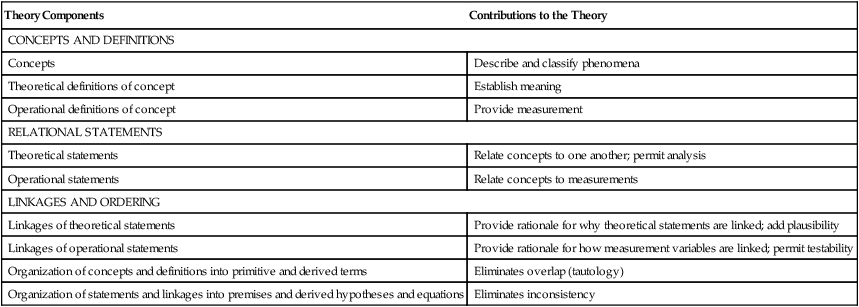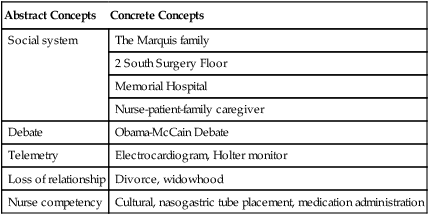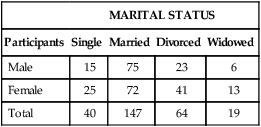Sonya R. Hardin and Sue Marquis Bishop Hage (1972) identified six theory components and specified the contributions that they make to theory (Table 4-1). Three categories of theory for these components are presented as a basis for understanding the function of each element in the theory-building process. Table 4-1 Theory Components and Their Contributions to the Theory Modified from Hage, J. (1972). Techniques and problems in theory construction in sociology. New York: John Wiley & Sons. Concepts, the building blocks of theories, classify the phenomena of interest (Kaplan, 1964). It is crucial that concepts are considered within the theoretical system in which they are embedded and from which they derive their meaning, because concepts may have different meanings in various theoretical systems. Scientific progress is based on critical review and testing of a researcher’s work by the scientific community. Concepts may be abstract or concrete. Abstract concepts are constructed mentally independent of a specific time or place, whereas concrete concepts are experienced directly and relate to a particular time or place (Chinn & Kramer, 2008; Hage, 1972; Reynolds, 1971). Concepts may be classified as discrete or continuous concepts. This system of labels differentiates types of concept that specify categories of phenomena. A discrete concept identifies categories or classes of phenomena, such as patient, nurse, health, or environment. A student can become a nurse or can choose another profession, but he or she cannot become a partial nurse. Phenomena identified as belonging to, or not belonging to, a given class or category may be called nonvariable concepts. Sorting phenomena into nonvariable, discrete categories conveys the assumption that the associated reality is captured by the classification (Hage, 1972). The amount or degree of the variable is not an issue. Theories may be used as a series of nonvariable discrete concepts (and subconcepts) that can be used to build typologies. Typologies are systematic arrangements of concepts within a given category. For example, a typology on marital status could be partitioned into marital statuses in which a population is classified as married, divorced, widowed, or single. These discrete categories could be partitioned further to permit the classification of an additional variable in this typology. A typology of marital status and gender is shown in Table 4-2. Participants are of one gender or the other; no degree of how much they adhere to this is shown in this discrete category. If the illustration is taken further, the typology can be partitioned while the discrete concept of children is added. Participants would be classified for gender and marital status, and as having or not having children. Table 4-2 Typology of Marital Status and Gender Continuous concepts are not expressed in either/or terms but rather in degrees on a continuum. The use of variable concepts on a continuum tends to focus on one dimension but does so without assuming that a single dimension captures all of the reality of the phenomenon. Additional dimensions may be devised to measure additional aspects of the phenomenon. Instruments may measure a concept and may have subscales that measure discrete concepts related to the overall concept. Variable concepts, such as ratio of professional to nonprofessional staff, communication flow, or ratio of registered nurses to patients, are used to characterize healthcare organizations. Although nonvariable concepts are useful in classifying phenomena in theory development, Hage (1972) points out major breakthroughs in several disciplines as the focus shifted from nonvariable to variable concepts, because variable concepts permit scoring of the full range of variation of the phenomenon. The development of concepts, then, permits description and classification of phenomena (Hage, 1972). The labeled concept specifies boundaries for selecting phenomena for observation and for reasoning about the phenomena of interest. New concepts may focus attention on new phenomena or may facilitate thinking about phenomena in a different way (Hage, 1972). Scholarly analysis of the concepts in nursing theories is a critical beginning step in the process of theoretical inquiry. The concept process continues to flourish, with many examples given in the nursing literature. See Table 4-3 for references to analyses carried out using different approaches. Table 4-3 Examples of Published Concept Analyses with Different Approaches Concept analysis is an important beginning step in the process of theory development undertaken to develop a conceptual definition. It is crucial that concepts are defined clearly to reduce ambiguity in the given concept or set of concepts. To eliminate perceived differences in meaning, explicit definitions are necessary. As the theory develops, theoretical and operational definitions provide the theorist’s meaning of the concept and the basis for empirical indicators. For example, Spear and Kulbok (2004) published a concept analysis of the autonomy of adolescents, in which autonomy was defined theoretically as independence or self-governance during the adolescent years. The concept of autonomy was operationalized as an active, individualized, holistic, contextual, and developmental process–oriented state of being. Theories are tested in reality; therefore the concepts must be linked to operational definitions that relate the concepts to observable phenomena specifying empirical indicators. See Table 4-4 for examples of concepts and their theoretical definitions and operational definitions. These linkages are vital to the logic of the theory, its observation, and its measurement. Table 4-4 Examples of Theoretical and Operational Definitions §Hatch, Burg, Naberhaus, & Hellmich, 1998. In connections between variables, one variable may be proposed to influence a second. In this case, the first variable may be viewed as the antecedent or determinant (independent) and the second as the consequent or resultant (dependent) variable (Giere, 1997). Zetterberg (1966) concluded that the development of two-variate theoretical statements could be an important intermediate step in the development of a theory. These statements can be reformulated later as the theory evolves, or as new information becomes available. An example of an antecedent and a consequence is explained by looking at the concept of autonomy in which the antecedents of autonomy were identified as experience, education, ability to prioritize, ability to discriminate, self-discipline, and acceptance of responsibility; consequences are identified with accountability. These antecedents and consequences were developed from the literature (Keenan, 1999). Theoretical assertions are a necessary or sufficient condition, or both. These labels characterize conditions that help explain the nature of the relationship between two variables in theoretical statements. For example, a relational statement expressed as a sufficient condition could be the following: If nurses react with approval of patients’ self-care behaviors (NA), patients increase their efforts in self-care activities (PSC). This is a type of compound statement that links antecedent and consequent variables. The statement does not assert the truth of the antecedent. Rather, the assertion is made that if the antecedent is true, then the consequence is true (Giere, 1979). In addition, no assertion appears in the statement to explain why the antecedent is related to the consequence. In symbolic notation form, the statements may be expressed as follows:
Theory Development Process
THEORY COMPONENTS
Theory Components
Contributions to the Theory
CONCEPTS AND DEFINITIONS
Concepts
Describe and classify phenomena
Theoretical definitions of concept
Establish meaning
Operational definitions of concept
Provide measurement
RELATIONAL STATEMENTS
Theoretical statements
Relate concepts to one another; permit analysis
Operational statements
Relate concepts to measurements
LINKAGES AND ORDERING
Linkages of theoretical statements
Provide rationale for why theoretical statements are linked; add plausibility
Linkages of operational statements
Provide rationale for how measurement variables are linked; permit testability
Organization of concepts and definitions into primitive and derived terms
Eliminates overlap (tautology)
Organization of statements and linkages into premises and derived hypotheses and equations
Eliminates inconsistency

Concepts and Definitions
Abstract Concepts
Concrete Concepts
Social system
The Marquis family
2 South Surgery Floor
Memorial Hospital
Nurse-patient-family caregiver
Debate
Obama-McCain Debate
Telemetry
Electrocardiogram, Holter monitor
Loss of relationship
Divorce, widowhood
Nurse competency
Cultural, nasogastric tube placement, medication administration

MARITAL STATUS
Participants
Single
Married
Divorced
Widowed
Male
15
75
23
6
Female
25
72
41
13
Total
40
147
64
19



Concept
Approach
Author
Spirituality
Chinn & Kramer (2008)
Buck (2006)
Readiness to change
Chinn & Kramer (2008)
Dalton & Gottlieb (2003)
Facilitation
Morse (1995)
Harvey, et al. (2002)
Ethical sensitivity
Morse (1995)
Weaver, Morse, & Mitcham (2008)
Self-management of child and adolescent type 1 diabetes
Rodgers (1989)
Schilling, Grey, & Knafl (2002)
Risk
Rodgers (1989)
O’Byrne (2008)
Symptom perception
Schwartz-Barcott & Kim (2000)
Posey (2006)
Being sensitive
Schwartz-Barcott & Kim (2000)
Sayers & de Vries (2008)
Authenticity
Walker & Avant (2005)
Starr (2008)
Competency
Walker & Avant (2005)
Scott Tilley (2008)
Concept
Theoretical Definition
Operational Definition
Body temperature
Homeothermic range of one’s internal environment maintained by the thermoregulatory system of the human body
Degree of temperature measured by oral thermometer taken for 1 minute under the tongue
Heart failure
Inadequate cardiac function to meet circulatory demands*
Stage of heart failure is measured by the New York Heart Association (NYHA) classification†
Spirituality
A pan-dimensional awareness of the mutual human/environmental field process (integrality) as a manifestation of higher frequency patterning (resonancy) associated with innovative, increasingly creative and diverse (helicy) experiences‡

Relational Statements

![]()
Stay updated, free articles. Join our Telegram channel

Full access? Get Clinical Tree


Theory Development Process
Get Clinical Tree app for offline access


